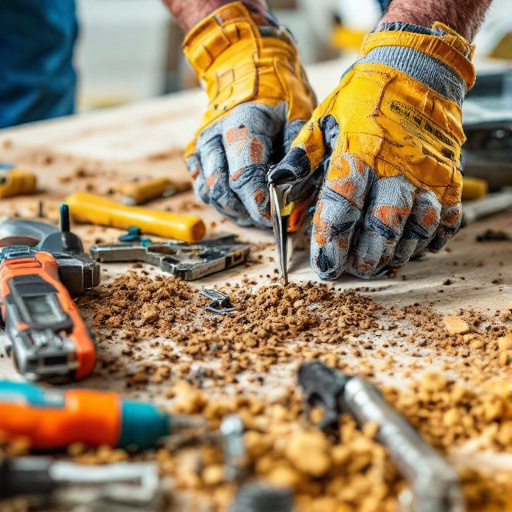Featured Articles
- Repairing Relationships: The Surprising Role of Home Repair Services in Strengthening Family Bonds
- Revolutionizing Home Repair: The Rise of DIY AI Assistants in Fixing Household Problems
- The Hidden Costs of DIY: When Home Repair Projects Become Money Pits
- The Hidden Costs of DIY: When Home Repairs Turn into Financial Nightmares
- The Rise of DIY Disaster Stories: When Home Repair Services Become a Last Resort
The Rise of DIY Disaster Stories: When Home Repair Services Become a Last Resort
The Rise of DIY Disaster Stories: When Home Repair Services Become a Last Resort
The rise of DIY (Do It Yourself) culture has empowered homeowners to take on home repairs, but it's often accompanied by tales of ruined projects and costly corrections. While the intention may be to save money, many find themselves calling professional services as a last resort after discovering that not every job is suited for a weekend warrior.
Trending Topics: DIY Culture and Its Pitfalls
The surge of interest in DIY projects surged about a decade ago, with platforms like Pinterest and YouTube inspiring a new generation of creative home improvers. According to a survey conducted by HomeAdvisor, around 70% of Americans have attempted DIY projects in their homes over the past two years, with nearly 15% admitting to regretting those decisions due to unexpected complications. HomeAdvisor
The Good, the Bad, and the Ugly
Let’s be honest: not everyone is born with a hammer in their hand, and that's perfectly okay! Many experience hilarious DIY failures that become epic tales of caution for friends and family. Take the example of 30-year-old Sarah Wilson from Portland, Oregon. Motivated by a viral video, she opted to renovate her bathroom without any experience. A week later, she found herself knee-deep in a failed plumbing attempt, which resulted in a waterfall cascading down her living room ceiling!
This story highlights a central truth: while DIY can provide a sense of accomplishment, it's not without risks. Sarah's experience also cost her an additional $5,000 to hire professionals to fix what she thought would be a simple weekend project. Her story is just one of many that exemplifies the challenges posed by home improvement ventures—challenges that all too often lead people back to the very services they aimed to avoid.
When Passion Meets Reality
Let's explore the mentality behind DIY projects. Many individuals are driven by the desire to save money, others seek creative outlets, and some just like the thrill of learning something new. The problem arises when this enthusiasm meets the reality of electrical wiring or foundation repair. A 2020 survey by the National Association of Home Builders noted that about 37% of homeowners regretted attempting DIY projects due to insufficient knowledge or skills. NAHB
Case Study: The Sinking Ship (Literally)
In a small town in Michigan, a family of four decided to take on the challenge of building a deck overlooking their tranquil lake. Eager to kickstart their summer, they pulled together a crew of friends and family, excited to share ice-cold lemonade amidst their new creation. However, as they began placing the posts, they inadvertently dug into the wrong soil—leading to a shoddily constructed deck that eventually sank into the water, taking with it the hopes of summer barbeques. In a comical twist, this family ended up hiring a contractor not only to reconstruct the deck but also to dredge the lake and retrieve their “dream” deck, costing them over $12,000.
Behind the Scenes: Statistics & Failures
Statistics indicate that DIY home improvement projects can often lead to unexpected additional costs. According to HomeAdvisor’s 2021 report, 50% of DIY-ers reported incurring expenses that were double or even triple what they intended to spend before calling in the pros. This could be attributed to a lack of planning, insufficient research, or the infamous “it looks easier than it is” syndrome.
The Cost of Calling It Quits
To state the obvious, DIY projects often require precise skills that aren't instinctual for the average homeowner. Homes are complex organisms; plumbing, electrical systems, and structural elements create a puzzle that requires expert knowledge. A poorly done job can not only lead to monetary loss but also safety hazards. For instance, improper electrical work can result in house fires or severe electrical shock, with National Fire Protection Association reports attributing approximately 69% of electrical fires to faulty wiring and connections. NFPA
Laughing Through the Madness: A Humorous Outlook
Turning to humor can ease the sting of DIY disaster stories. Social media platforms have become galleries of DIY fails, where cringe-worthy mistakes are shared not just for warnings but for sheer laughter too. There’s a recent trend on TikTok where users post a before-and-after comparison of their projects, with the after often being a ‘what not to do’ scenario. One user shared a video of her attempted painting project that left her kitchen looking like a crime scene, resulting not just in a hasty repaint but a serious reason to hire a cleaning crew!
Professional Services: The Safety Net
So when does one know it’s time to call in the professionals? A good rule of thumb is if you encounter a project that involves potentially dangerous materials—like electricity or gas—or if you feel overwhelmed and unsure of how to proceed. The smart DIY-er knows that it’s not just about your capabilities but also about the quality and longevity of the work in your home. That’s when home repair services become not just a last resort but actually an investment.
Let’s Talk Solutions: Getting Help
For those faced with overwhelming projects, there’s a range of home repair services available. These range from licensed electricians and plumbers to general contractors equipped to handle a multitude of home repairs. Many homeowners have realized that while DIY may seem cheaper in theory, hiring a professional often results in decreased costs in the long run due to their expertise. According to a study by the Remodeling Magazine, homes that showed proof of renovations conducted by professionals retained more value than those done by DIY-ers. Remodeling Magazine
The Future of DIY: A Balanced Approach
As we stride into the future of home improvement, the key takeaway is balance. Embracing the DIY movement while acknowledging its limitations will pave the way for a more efficient approach to home repair. There’s a distinct difference between minor updates, like painting furniture, and major projects like an entire kitchen remodel. Education is crucial—consider taking classes at a local hardware store or watching detailed tutorials before diving into projects.
Telling Your Own Story!
To truly capture the spirit of DIY culture, one cannot forget the value of storytelling. Everyone has a DIY horror story waiting to be told, and those experiences often become the foundation for future cautionary tales. Whether through lunch conversations or community blogs, sharing these stories helps inspire others to tread carefully in their own home repairs.
In conclusion, the rise of DIY disaster stories serves as both a humorous reminder and a cautionary tale for homeowners. With a mix of creativity and caution, it’s possible to tackle home projects without falling into the pitfalls that so many others have encountered. As the saying goes, “An ounce of prevention is worth a pound of cure”—and in the world of DIY, that couldn’t be more applicable.




